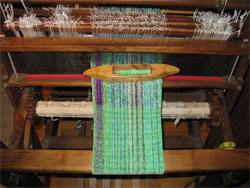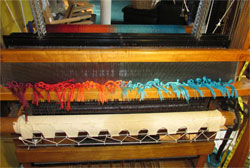My first weaving loom was about 4″ square, made of metal, and had ‘teeth’ along all for sides. I was about 6 or 7, and I bet my mom had dozens of potholders I made on that loom. I loved the bright colors of the loopers and used as many as I could. Although they were functional, in hindsight, I’m sure they were less than beautiful.
A few years later the Girl Scouts taught me how to make lanyards out of boondoggle. This was a type of off-loom weaving, sort of like creating childhood precursers to amazing kumihimo cords.
Then I learned to knit, sew, and embroider. As time went by I expanded my techniques, adding crochet, macrame, bargello, and other fiber arts to my skills. The years continued to pass and I wanted to learn to weave on a multi-harness loom. I took 6 hours of classes and was in love with the process – it’s rhythmic and mathematical natures spoke to me.
Not even realizing how little I knew, I jumped in with both feet and bought a old, handmade counterbalance loom on CraigsList. Having sat idle for decades, the loom needed lots of TLC to bring it back to functioning. As I worked through the restoration step by step, I learned tons about how looms function and gained confidence. Then I set about with my self-education. I learned with every project I took on, exploring fibers and structures not discussed in class. Since I was living in a very rural area, almost all was learn by doing with assistance from books. Still, since I was weaving at least 20 hours a week, things progressed well.
I’d learned a lot on my little 4-harness counterbalance loom and after a few years wanted to expand my horizons. I kept my eyes out for a used 8-harness loom, and was thrilled to find one that was very affordable just a few miles from home. And it was a Macomber — a great name in looms.
Why such a bargain? The loom was literally in pieces in someone’s (fortunately dry) barn. So once again I had to do lots of restoration, this time starting with assembly. Again, I learned a great deal before it was even fully assembled. After it was set up it took me years, literally, to become good friends with her. My counterbalance is so small, so easy to treadle, sized just right for my small frame, that this beefy jack loom seemed like a bear – hard to reach everything, much more force needed to treadle, harder to tie up…too much loom for me? Or just the wrong loom for me? Keeping more than full-time hours, as months and then years passed I learned to not just like, but to love my Mac. I now do most of my weaving on her. Along the way I picked up two small, old looms, and restored both, using them primarily for demonstration purposes since they’re very portable.
In 2011 I was accepted as a Roycroft Renaissance Artisan. This gave further impetus to both expand my weaving horizons and achieve excellence with every piece I wove. Many more hours at the loom plus input from other Master Artisans and weavers, and in 2015 I was thrilled to achieve Master Artisan status with my weaving. I had to drop out of the Association in 2020, when my family obligations and a hand injury dramatically reduced the amount of time I could spend at my loom.
That same year I moved out of the country house I’d built with my husband and into a small city house to be near my kids and grandkids. Lots to miss at the old place, lots to love in the new setting. In addition to being close to family, I love my new 10′ x 20′ weaving studio with all the natural light a person could dream for! I wove at least 40 hours per week for a few more years in my new space. Since the middle of 2019 I’ve been weaving only part time, probably more like 20 hours per week – but that includes taking care of all the other parts of the business, too. I guess I’ll call this partial retirement.


